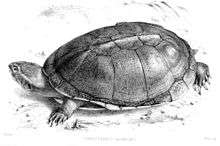Adanson's mud turtle
| Adanson's mud turtle | |
|---|---|
 | |
| Scientific classification | |
| Kingdom: | Animalia |
| Phylum: | Chordata |
| Class: | Reptilia |
| Order: | Testudines |
| Family: | Pelomedusidae |
| Genus: | Pelusios |
| Species: | P. adansonii |
| Binomial name | |
| Pelusios adansonii (Schweigger, 1812)[1][2] | |
| Synonyms[2] | |
| |
Adanson’s mud turtle (Pelusios adansonii) is a species of turtle in the family Pelomedusidae. It is endemic to central Africa.[3] August Friedrich Schweigger first described the turtle in 1812, based on remnants found by Michel Adanson in Senegal.[4]
Distribution
It is found in Benin, Cameroon, the Central African Republic, Chad, Ethiopia, Mali, Mauritania, Niger, Nigeria, Senegal, South Sudan, and Sudan.[1] There are at least three distinct populations within the turtle's distribution.[1]
Although Adanson's mud turtle does not seem to be at risk of becoming an endangered species, destruction of its habitat (largely due to farming) and hunting by humans have both reduced its population.[4][5] Hunting by humans persists despite local laws forbidding the activity in some of the countries in which the turtle is found.[4]
Characteristics
Adanson's mud turtle is a medium-sized turtle that lives in freshwater. The turtle's shell can grow up to 238 mm (9.4 in) and is known to be sharp and rigid. The shell also has dark brown spots and dashes. The ventral part of the shell is yellow.[5]
Adanson's mud turtle is carnivorous.[3] It eats mollusks, fish, and small amphibians.[3]
Reserve
A refuge for Adanson's mud turtle has taken place in the wetland area on the northwest side of Guiers Lake in northern Senegal and it covers about 750 acres (1.17 sq mi). It is the first refuge of its kind that is dedicated to the conservation of Adanson's mud turtle and its nesting and foraging habits. It was created with the help of the Turtle Survival Alliance (TSA Africa) and the Ministry of Environment and Nature Protection of Senegal.[6]
References
- 1 2 3 Rhodin, Anders G. J.; van Dijk, Peter Paul; Inverson, John B.; Shaffer, H. Bradley; Roger, Bour (2011). "Turtles of the world, 2011 update: Annotated checklist of taxonomy, synonymy, distribution and conservation status" (PDF). Chelonian Research Monographs. 6. Archived (PDF) from the original on 2012-01-22.
- 1 2 Fritz, Uwe; Havaš, Peter (2007-10-31). "Checklist of Chelonians of the World" (pdf). Archived (PDF) from the original on 2010-12-29. Retrieved 2010-12-29.
- 1 2 3 Bour, Roger (30 June 2008). "Pelusios adansonii (Schweigger 1812) – Adanson's Mud Turtle". Conservation Biology of Freshwater Turtles and Tortoises. Chelonian Research Foundation.
- 1 2 3 "Adanson's Terrapin at Tocc-Tocc Reserve". African Chelonian Institute. Retrieved 25 October 2016.
- 1 2 "Summary – Pelusios adansonii". IUCN Tortoise and Freshwater Turtle Specialist Group. Retrieved 30 December 2012.
- ↑ "Adanson's Mud Terrapin (Pelusios adansonii)". Retrieved 30 December 2012.
External links
- Pelusios adansonii (Schweigger 1812) – Adanson's mud turtle
 Data related to Pelusios adansonii at Wikispecies
Data related to Pelusios adansonii at Wikispecies